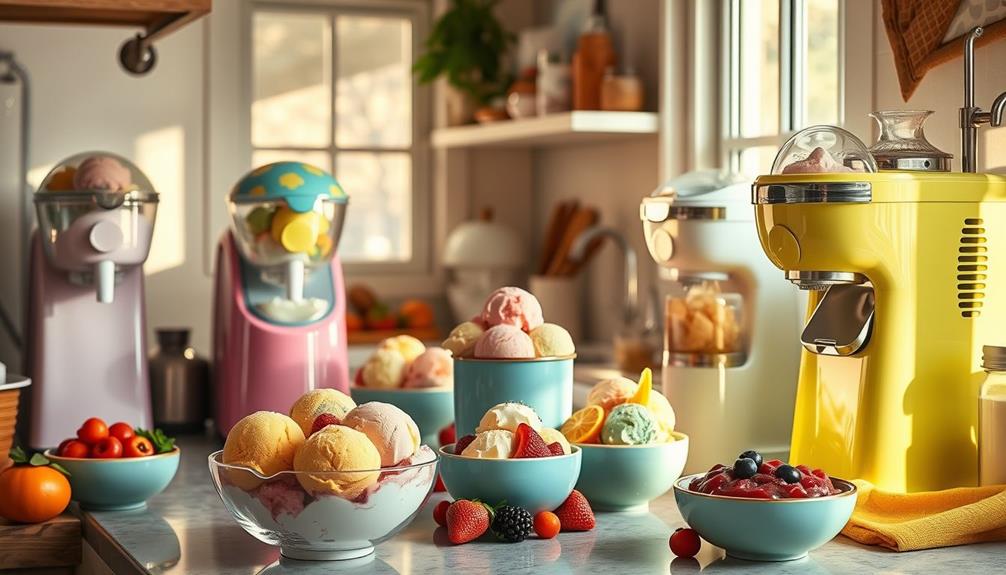Fried ice cream is a delicious dessert that combines a crispy outer shell with a cold, creamy interior. You'll find round scoops of ice cream coated in crushed cornflakes and cinnamon, quickly deep-fried for just 10-15 seconds. This brief frying creates a warm and crunchy exterior while keeping the inside perfectly frozen. Often served with toppings like whipped cream, chocolate sauce, or cherries, it's a popular treat at fairs and restaurants. If you're curious about its origins, preparation tips, and variations, there's a lot more to explore!
Key Takeaways
- Fried ice cream is a dessert featuring cold ice cream coated in a crispy exterior made of crushed cornflakes and cinnamon.
- It is briefly deep-fried at 375°F for 10-15 seconds, maintaining a creamy interior.
- Popular at state fairs and restaurants, it offers a unique contrast of hot and cold textures.
- Often garnished with toppings like whipped cream, chocolate sauce, and maraschino cherries for added flavor.
- Fried ice cream has cultural ties to Asian and Mexican cuisines and gained popularity in the U.S. during the 1970s.
What Is Fried Ice Cream?
Fried ice cream is a unique dessert that combines the contrasting sensations of hot and cold in every bite. This delightful treat features round scoops of ice cream, often referred to as ice cream balls, which are coated in a crunchy layer made from crushed cornflakes and cinnamon.
The magic happens when these coated ice cream balls are briefly deep-fried in oil heated to about 375°F (190°C) for just 10-15 seconds. This quick fry creates a golden brown, crispy exterior while keeping the interior cold and creamy.
It's important to note that while fried ice cream is a delicious indulgence, some of its toppings, like honey, are generally avoided by vegans due to ethical concerns about bee exploitation ethical concerns about bee treatment.
Fried ice cream isn't just about the delicious texture; it's also a feast for the eyes. You can enhance your dessert with various toppings such as whipped cream, chocolate sauce, or honey, and even finish it off with a maraschino cherry.
This dessert has a rich history, gaining popularity at the 1893 Chicago World's Fair, and it often finds its place in Asian and Mexican cuisines through different cultural adaptations.
While it's an indulgent treat, be mindful that the frying process typically results in higher calorie and fat content, making it a special occasion dessert you won't want to miss!
Recipe Overview

Fried ice cream offers a delicious contrast between its crunchy exterior and creamy interior, making it a unique dessert experience. The hot, crispy coating paired with the cold ice cream creates a delightful temperature and texture interplay that excites the palate. With each bite, the sensation is both comforting and intriguing, leaving you wanting more. For those curious about its potential health effects, one might even wonder, does ice cream ease heartburn? While the cold nature of ice cream might provide temporary relief by soothing the esophagus, its high-fat content could potentially exacerbate heartburn for some individuals.
This delightful treat can be enhanced by incorporating innovative flavor profiles that surprise your taste buds.
You'll love experimenting with popular toppings like whipped cream, honey, and cherries to elevate the flavors.
This treat not only impresses but also invites sharing, with each recipe yielding eight delightful servings.
Unique Dessert Experience
Imagine a dessert that combines the unexpected crunch of a golden coating with the smooth creaminess of ice cream—this is fried ice cream. This unique treat provides an exhilarating contrast in textures that delights the senses.
To prepare it, you'll start by scooping ice cream into balls and placing them on a baking sheet. Make sure to freeze these scoops until they're firm, ensuring they hold their shape during frying. For added creativity, consider experimenting with flavors or toppings, similar to how you can customize easy homemade flautas with various fillings.
Next, dip each chilled scoop in egg whites, allowing them to coat the ice cream evenly. Then, roll them in crushed cornflakes for that signature crispy exterior. The real magic happens when you fry these coated ice cream balls briefly at 375°F (190°C). This quick cooking time yields a golden, crunchy shell while keeping the ice cream inside perfectly creamy.
Serving fried ice cream immediately after frying is essential to maintain its ideal texture and flavor. With a recipe that yields eight delightful 1/2-cup-sized portions, you'll have just the right amount to share at your next gathering, creating a truly unforgettable dessert experience.
Popular Toppings Options
When it comes to elevating your fried ice cream, there are several popular toppings that can enhance its deliciousness. Whipped cream is a must; it adds a light, airy texture that complements the creamy interior and crunchy exterior of the ice cream.
For a really nice touch, drizzle honey or chocolate sauce over the top, creating a sweet contrast that takes your dessert to a new level.
Maraschino cherries are a classic garnish that not only provide a pop of color but also a fruity element that brightens the dish. You can also sprinkle cinnamon and sugar on top, echoing the flavors of the cornflake coating for a delightful finish.
If you want to get creative, consider customizing with nuts, sprinkles, or crushed cookies, letting your taste preferences shine through.
If you're in New York, you might find fried ice cream served with a twist, reminiscent of Baked Alaska. This dessert takes the fried ice cream concept to another level, combining elements of both favorites.
No matter how you choose to top yours, these options are sure to create a memorable treat!
Ingredients and Preparation

To make fried ice cream, you'll need some key ingredients like ice cream, cornflakes, and egg whites.
Start by preparing the ice cream balls and coating them for that perfect crunch.
Let's explore the steps and techniques to get your dessert just right!
Essential Ingredients Needed
Fried ice cream often delights dessert lovers with its unique combination of hot and cold. To create this indulgent treat, you'll need a few essential ingredients. First, choose your favorite ice cream flavor; classic options like vanilla or chocolate work wonderfully.
Next, you'll require cornflakes to create that crispy coating. Mixing crushed cornflakes with sugar and cinnamon adds flavor and texture to your dessert.
Egg whites are critical as they act as a binding agent, making certain the cornflake coating adheres to the ice cream balls.
To prepare your ice cream, scoop it into 2-inch balls and freeze them for at least 30 minutes. This step helps maintain the shape during frying.
Once the ice cream balls are coated with the cornflake mixture, it's important to freeze them again for an additional three hours or even up to three days. This extra freezing guarantees that the ice cream remains firm while frying.
Preparation Steps Overview
For a successful fried ice cream experience, start by selecting your favorite ice cream flavors. Scoop them into 2-inch balls and freeze these scoops for about 30 minutes. This step helps maintain their shape during frying.
Next, prepare your coating mixture by following these steps:
- Crush Cornflakes: Crush cornflakes into smaller pieces and mix them with sugar and cinnamon in a shallow dish for that perfect crunchy texture.
- Egg Whites: Roll the frozen ice cream balls in egg whites. This will help the coating stick better.
- Coat Again: After rolling in egg whites, coat the balls again in the cornflake mixture for extra crunch.
- Freeze Again: Place the coated ice cream balls on a parchment-lined baking sheet and freeze them for at least 3 hours, or up to 3 days, to solidify the coating.
When you're ready to fry, heat oil to 360°F. Fry the ice cream balls for just 8-10 seconds until they turn a lovely golden brown. Enjoy your crispy, indulgent treat!
Coating Techniques Explained
Achieving that perfect crunchy exterior for your fried ice cream requires a simple yet effective coating technique. Start by rolling your frozen ice cream balls in a mixture of crushed cornflakes and cinnamon, making sure to cover them evenly. This initial layer gives your dessert that essential crunch.
Next, dip the coated ice cream balls in beaten egg whites. This step helps the second layer of cornflakes stick better, enhancing the texture. After the egg dip, roll the ice cream balls in the cornflake mixture again for an extra crunch. This double coating technique is key to achieving a delightful crunch when fried.
Once you've coated your ice cream balls, it's vital to freeze them for at least 3 hours. This helps maintain their shape and prevents them from melting during the frying process.
To streamline your coating routine, use a shallow dish for the cornflake mixture and a separate bowl for the egg whites. This setup minimizes mess and makes the process more efficient.
With these coating techniques, you'll be well on your way to creating a deliciously crispy fried ice cream treat. Enjoy!
Cooking Process

To create perfectly fried ice cream, start by heating oil to 375°F (190°C). This temperature is essential for achieving that crispy exterior while keeping the ice cream inside frozen.
Once the oil is ready, follow these steps to fry your coated ice cream balls:
- Fry in Batches: Carefully add one or two ice cream balls to the hot oil at a time. Fry them for 10-15 seconds, making sure they turn a beautiful golden brown.
- Use the Right Tools: Utilize a spider tool or slotted spoon to manage the frying process. This helps you carefully place the ice cream in the oil and remove it without splashing.
- Drain Excess Oil: After frying, immediately place the fried ice cream on paper towels. This will absorb any residual oil, giving you a cleaner presentation.
- Serve Quickly: Serve the fried ice cream right after frying. The heat can cause it to melt quickly, so enjoy it while it's still crispy and cold.
Following these steps guarantees you'll have a delicious treat that's both crispy and creamy—perfect for impressing your friends!
Nutritional Information

Enjoying fried ice cream comes with a few nutritional considerations. First off, this indulgent dessert tends to be high in calories. When fried, ice cream typically retains about 10% oil, which contributes to its overall calorie content. Depending on the specific ingredients you choose—like the type of ice cream or coating—nutritional values can vary considerably.
If you're following a standard 2,000 calorie diet, keep in mind that serving sizes can drastically affect your total calorie intake. The combination of ice cream, oil, and any additional toppings often makes fried ice cream a high-calorie treat. So, it's wise to be mindful of how much you enjoy in one sitting.
If you have specific dietary restrictions or health concerns, it's best to consult a healthcare professional for personalized nutritional advice. They can help you navigate the indulgence of fried ice cream while considering your unique needs.
Ultimately, while it's a delicious treat, being aware of its nutritional impact can help you make more informed choices without sacrificing enjoyment.
Origin of Fried Ice Cream

Fried ice cream has an intriguing history that dates back to the 1893 Chicago World's Fair, where it first captivated dessert lovers. This delicious treat gained popularity alongside the ice cream sundae, quickly becoming a staple in the dessert world.
The origins of fried ice cream can be summarized in a few key points:
- A Philadelphia company in 1894 is credited with inventing fried ice cream, describing it as ice cream encased in a pie crust and deep-fried.
- In the 1960s, some links emerged connecting fried ice cream to a Japanese tempura-like process, showcasing its cross-cultural influences.
- The dessert may also have roots in Baked Alaska, which originated in the 18th century, combining ice cream with a baked exterior.
- Over time, fried ice cream has been embraced by various cuisines, particularly Mexican and Asian, leading to adaptations and variations across regions.
This melding of cultures and techniques has solidified fried ice cream's place in dessert history, making it a beloved treat that continues to delight taste buds around the world.
Associations With National Cuisines

When you think of fried ice cream, you might picture it served in an Asian restaurant or at a festive fair.
Its roots in American dining, particularly through places like Chi-Chis, show how cultural influences shape this treat.
Globally, you'll find variations that reflect local tastes, making fried ice cream a delightful fusion of flavors.
American Restaurant Influence
American restaurants have greatly shaped the perception of international cuisines, often blending traditional dishes with local tastes to create unique dining experiences. Fried ice cream is a prime example, gaining popularity in the 1970s, especially within establishments serving Asian cuisine. You might associate this delightful dessert with Mexican cuisine, thanks to the restaurant chain Chi-Chi's, which popularized it starting in 1975.
Here are some ways American restaurants have influenced the fried ice cream experience:
- Cultural Fusion: The dish often showcases a blend of flavors, merging Asian and Mexican influences, which creates a unique dessert option.
- Toppings Galore: Many restaurants enhance the treat with drizzles of caramel sauce, chocolate syrup, or whipped cream, appealing to American sweet tooth preferences.
- Presentation Styles: The visual appeal of fried ice cream varies, with different restaurants serving it in creative ways that reflect local aesthetics.
- Versatility: While it's linked to Mexican cuisine in the U.S., fried ice cream also finds a place in Australian Chinese cuisine, showcasing its adaptability.
This versatility makes fried ice cream a fascinating part of the American dining landscape.
Cultural Variations Worldwide
Culinary traditions around the world have embraced fried ice cream, each putting its own spin on this delightful dessert. In the United States, it's often tied to Asian cuisine, gaining traction in the 1970s, especially in Mexican restaurants like Chi-Chis, which introduced it in 1975. Over in Australia, fried ice cream is a staple at Chinese restaurants, reflecting local adaptations.
Cultural variations are vast, with regions adding unique toppings or sauces. Some serve it drizzled with caramel, while others might use chocolate or fruit syrups. It's also a popular treat at state fairs across the U.S., loved by both kids and adults.
Here's a quick look at how different countries serve fried ice cream:
| Country | Typical Toppings | Culinary Influence |
|---|---|---|
| United States | Caramel, Chocolate | Asian and Mexican |
| Australia | Honey, Nuts | Australian Chinese |
| Mexico | Cinnamon, Chocolate | Traditional Mexican |
These variations showcase how fried ice cream adapts to local tastes, making it a truly global dessert. Enjoy exploring these delicious twists!
Toppings and Presentation

A variety of toppings can elevate fried ice cream, making it not only delicious but visually appealing. You can transform your dessert into a feast for the eyes and the palate with the right combination of toppings. Here are some popular choices to contemplate:
- Whipped Cream – A generous dollop adds creaminess and a light texture.
- Chocolate Sauce – Drizzling this sweet sauce creates a rich contrast against the crunchy exterior.
- Crushed Nuts – Sprinkling these on top adds a delightful crunch and flavor.
- Maraschino Cherry – This classic touch not only enhances flavor but also brings a pop of color.
For an extra touch of elegance, contemplate serving your fried ice cream in a decorative bowl or on a fancy plate.
You might also want to add elements like mint leaves for freshness or a sprinkle of cinnamon sugar for warmth.
By strategically placing your toppings, you can create an enticing visual display that invites everyone to dig in.
With these toppings and presentation tips, your fried ice cream will be the star of any dessert table!
Popularity and Historical Context

Fried ice cream has captivated dessert lovers since its debut at the 1893 Chicago World's Fair, where it first made waves alongside the ice cream sundae. Its unique combination of hot and cold quickly caught on, but it wasn't until the 1970s that it truly gained popularity, particularly in U.S. restaurants.
You might notice it often paired with Asian cuisine, yet its strong ties to Mexican culture, especially through the Chi-Chi's restaurant chain, helped solidify its place in the dessert world after 1975.
The dish showcases a blend of culinary traditions, adapting to various tastes and preferences. You can find countless variations, with different coatings and toppings that keep it fresh and exciting.
Today, fried ice cream remains a favorite treat at state fairs and festivals, drawing in crowds with its enticing texture and fun presentation. Whether you're a child or an adult, there's something delightful about digging into this crispy, creamy dessert.
Its journey from a World's Fair novelty to a beloved staple illustrates how food evolves and connects cultures, making fried ice cream not just a dessert, but a shared experience you won't forget.
Related Desserts

Dessert lovers often explore a variety of sweet treats that share similarities with fried ice cream, each offering its own unique twist on the hot-and-cold experience.
Here are some related desserts you might want to try:
- Baked Alaska: This classic dessert features ice cream encased in cake and topped with meringue. It's quickly baked to create that delightful contrast between warm and cold.
- Deep Fried Mars Bar: If you're craving something indulgent, this treat has a battered and deep-fried Mars Bar, resulting in a gooey, chocolatey center with a crispy exterior.
- Fried Milk: A unique Chinese dessert, it involves freezing milk, cutting it into pieces, coating it with batter, and frying until golden, giving you a creamy flavor that's hard to resist.
- Churros with Ice Cream: These Spanish pastries can be served with chocolate sauce and even filled with ice cream, offering a perfect blend of warm and cold textures.
- Mochi Ice Cream: This Japanese-inspired delight wraps ice cream in sweet rice dough, providing a chewy texture and a variety of flavor combinations to explore.
These desserts are sure to satisfy your sweet tooth!
Frequently Asked Questions
What Is Fried Ice Cream Made Of?
Fried ice cream's made from scoops of ice cream, coated in a mixture of crushed cornflakes and cinnamon, dipped in beaten egg whites, then quickly fried until golden brown for a crunchy, delicious treat.
Why Do Mexican Restaurants Have Fried Ice Cream?
Mexican restaurants serve fried ice cream because it combines cultural flavors with a fun, unique presentation. You'll love the crunchy coating and customizable toppings, making it an exciting and indulgent dessert choice that enhances your dining experience.
How Is Fried Ice Cream Still Cold?
Fried ice cream stays cold because it's frozen solid before frying. The brief cooking time creates a crispy layer while keeping the inner ice cream insulated, preventing it from melting during the quick frying process.
Is Fried Ice Cream Chinese or Japanese?
So, you think fried ice cream's a culinary identity crisis? It's neither strictly Chinese nor Japanese. Its roots mingle across cultures, making it a delicious paradox, embraced worldwide, regardless of where it claims to belong.
Conclusion
In the delightful dance of textures and temperatures, fried ice cream captivates your senses like a sweet serenade. The crispy, golden shell gives way to a cool, creamy heart, creating a symphony of sensations that lingers on your palate. Whether enjoyed at a festive gathering or a cozy night in, this whimsical treat reminds you that life's simplest pleasures can be the most extraordinary. So, plunge in and let each bite whisk you away to a world of indulgence.










